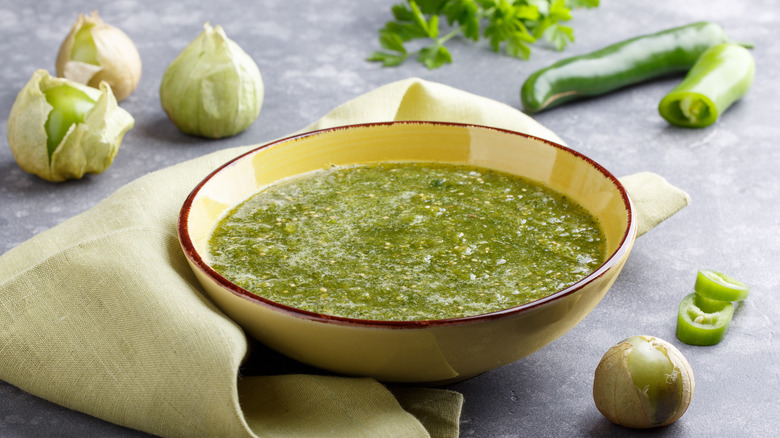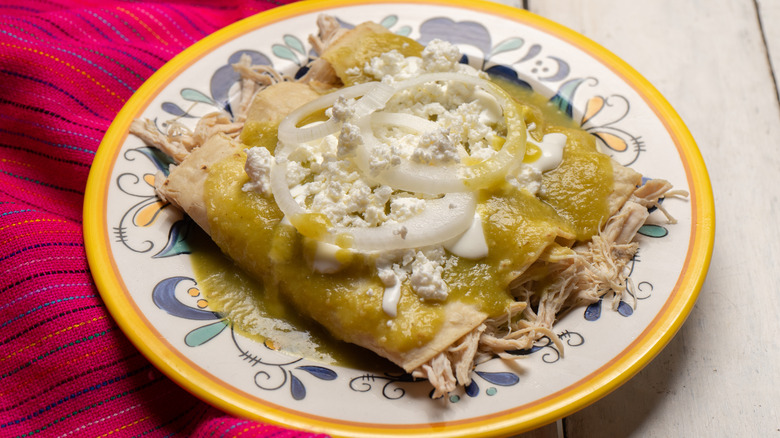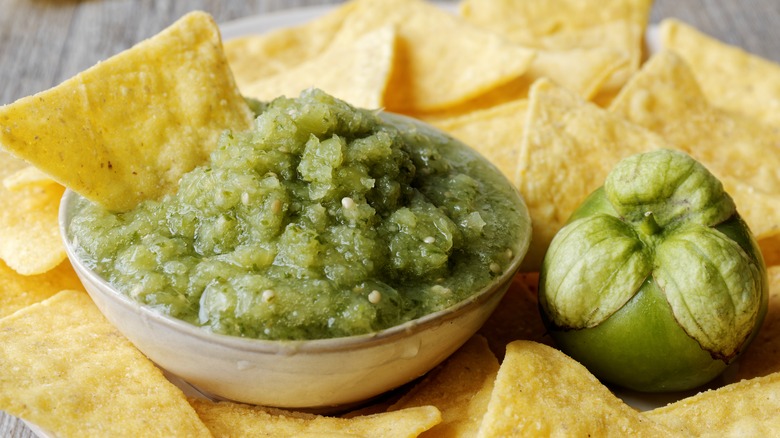The Major Differences Between Green Enchilada Sauce And Salsa Verde
You might think green enchilada sauce and salsa verde are the same, but think again before you swap one for the other when testing a new recipe. That's because there are key differences between the two Mexican sauces, including the ingredients, how they're made, and what they're used for. Typically, green enchilada sauce is mostly used when cooking enchiladas, while salsa verde is used on a variety of dishes, including tacos, just like any other salsa or hot sauce.
The biggest difference between the two condiments is that enchilada sauce is made of cooked ingredients whereas salsa verde is concocted of raw ingredients (Don't worry, we'll get into what those ingredients are soon). Another key difference is the consistency. Green enchilada sauce is thinner than salsa verde and is cut with stock or water. Salsa verde, on the other hand, skips the liquid and consists only of vegetables and peppers blended together. When it comes to taste, salsa verde is fresher because of raw ingredients like herbs and spices while enchilada sauce is more savory.
What is green enchilada sauce?
You've probably tasted green enchilada sauce if you've ever had enchiladas verdes, a version of enchiladas filled with protein, like chicken, and topped with the sauce. For a bit of history, enchiladas originated with the Mayans centuries ago. These days, you can order them at basically any Mexican restaurant you walk into. The typical ingredients in green enchilada sauce are tomatillos, jalapeños, cilantro, garlic, onion, oil, and lime juice. Some recipes also include green chiles or poblano peppers, depending on the desired spice level.
You can buy authentic enchilada sauce in a can or jar at the grocery store for a quick version of enchiladas verdes. Or, if you're a shining home cook who wants to try it on your own, here are the basics of how it's made. You start by roasting the tomatillos and peppers in the oven and chopping the rest of the ingredients, then everything is blended together, thinned out into a sauce, and cooked on the stovetop. The result is a mild to spicy sauce that you can top your enchiladas with or freeze for later.
How is salsa verde different?
Salsa verde is much more versatile than green enchilada sauce because you can really use it on any food that you would use hot sauce or other salsas on. Because it's a staple of Mexican cuisine, you've most likely had it on tacos or chilaquiles, but there are modern-day casserole and soup recipes that also incorporate salsa verde as the star of the dish. Similar to the Mayan roots of enchilada sauce, the origins of salsa verde date all the way back to the Aztec empire. You've probably seen a jar of this delicious salsa on the shelves next to the traditional red salsas that you might be more acquainted with.
The main ingredients include tomatillos, white onions, garlic, cilantro, jalapeños, serrano peppers, lime juice, and salt. Some recipes also use oregano and other pepper varieties to up the spiciness. The key difference in preparation compared to enchilada sauce is that only the tomatillos are cooked, which are boiled or roasted to soften and bring out the flavors. The rest of the ingredients are blended or chopped together into salsa. Like most foods, it's best eaten fresh, but you can keep it in the fridge for two or three days or freeze it for later.


